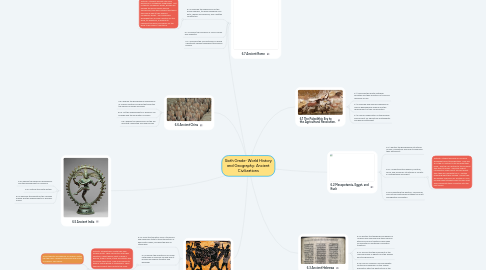
1. 6.5 Ancient India
1.1. 6.5.3 Explain the beliefs of Brahmanism and the development of Hinduism.
1.2. 6.5.4 Outline the caste system.
1.3. 6.5.6 Describe the growth of the Mauryan empire and the achievements of Emperor Asoka.
2. 6.6 Ancient China
2.1. 6.6.2 Explain the geographical significance of China's isolation and how that effected the spread of goods and ideas.
2.2. 6.6.5 List the achievements of Emperor Shi Huangdi and the unification of China.
2.3. 6.6.7 Explain the significance of the silk road that connected Asia and Europe.
3. 6.4 Ancient Greece
3.1. 6.4.2 Trace the transition from a tyrannical and oligarchic state to the introduction of democratic ideas, including the idea of citizenship.
3.2. 6.4.4 Explain the importance of Greek mythology in everyday life and how it influenced modern literature and language.
3.2.1. Activity: Students will create their own modern myth. They can write a one page narrative, a short poem, paint or draw a picture, make a song, or use any artistic way to convey their story. They may choose to work in a small group or individually. Then they will present their myth to the class.
3.2.1.1. Give students and example of modern myths like the Percy Jackson book series and movie or Marvel's Thor series.
3.3. 6.4.6 Compare and contrast ancient life between the Athenian and Spartan cultures and their roles in the Persian and Peloponnesian Wars.
4. 6.7 Ancient Rome
4.1. 6.7.2 Describe the significance of the Roma Republic, its ideas regarding civic duty, checks and balances, and a written constitution.
4.1.1. Activity: Students will get into small groups for a vocabulary assignment. Out of twenty vocabulary words, groups will divided the words evenly among themselves, then each student will teach their group about their specific vocabulary words. The vocabulary worksheet will include a section for the word, its definition, a drawing to represent the word, and space for the word to be used in a sentence.
4.2. 6.7.4 Discuss the influence of Julius Caesar and Augustus.
4.3. 6.7.7 Describe the circumstances in which Christianity spread throughout the Roman Empire.
5. 6.1 The Paleolithic Era to the Agricultural Revolution.
5.1. 6.1.1 Describe the hunter-gatherer societies and their invention of tools and discovery of fire.
5.2. 6.1.2 Describe how humans appeared in various geographical regions and the development of their communities.
5.3. 6.1.3 Human modification of the physical environment for agricultural sustainability and human settlement.
6. 6.2 Mesopotamia, Egypt, and Kush
6.1. 6.2.1 Identify the geographical structures of early civilizations and how it influenced their settlement.
6.2. 6.2.3 Understand the religious, political, social, and economic structured of society in Mesopotamia and Egypt.
6.2.1. Activity: Student will work on a KWLW worksheet about the Egyptians. They will fill in the "K" section to tell me what they know, and the "W" section to tell me what they want to know. I will play a short introduction video about Ancient Egypt then they will complete the "L" section regarding what they learned. Finally they will answer a second "W" section so I can uncover what students want to learn next and incorporate their curiosities into the next lesson.
